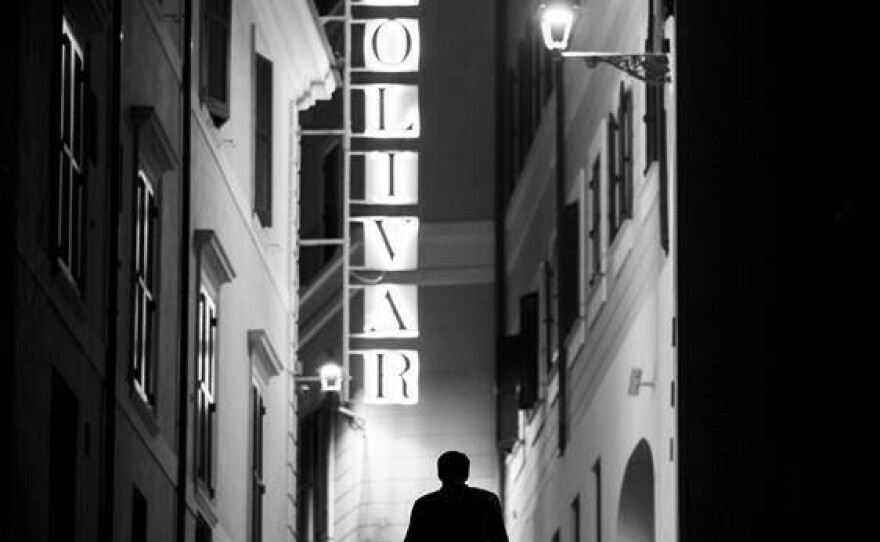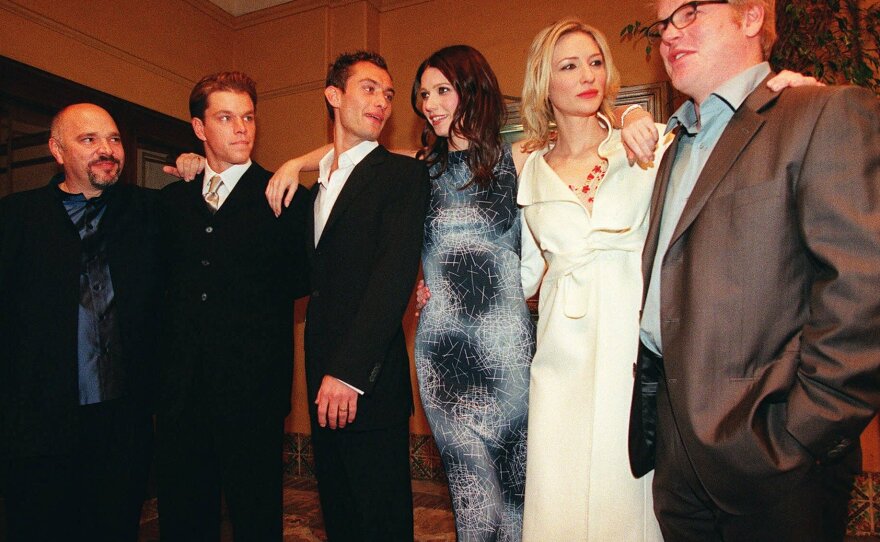For a total psychopath, Tom Ripley is remarkably popular. As we near the 25th anniversary of the acclaimed Oscar-nominated big screen adaptation of Patricia Highsmith's most infamous creation, The Talented Mr. Ripley, Netflix has released a striking new reimagining, simply titled Ripley. Sinister and visually stunning, the series reminds us why the book continues to influence popular culture.
Through seven decades, Highsmith's novel, The Talented Mr. Ripley has grown in allure as a masterwork of American noir, boosted by – but distinct from – its adaptations. The core story is always the same: A wealthy man enlists fraudster Tom Ripley, his son's distant acquaintance, to travel to Italy and woo his errant, playboy son back to the fold; but rather than returning Dickie to his family, an envious Tom disposes of him and assumes his identity. Other murders follow to cover the first.
This bloody-minded serial killer fantasist and antisocial social climber would become Patricia Highsmith's best known and best loved creation. She published five Ripley novels in all from 1955 to 1991, the last a few years before her death. Since his debut, her all-American psychopath has inspired six screen adaptations, a play by Phyllis Nagy, and a musical staging. That legacy is a testament to Ripley's complicated appeal – amoral, unassuming and audacious — and Highsmith's scalpel-sharp writing. There's something irresistible about an unapologetic grifter, who seizes the chance at a better life by stealing someone else's. The text is rich enough to handle wildly different interpretations that feel true to the original and brilliant in their own right.
A window into Ripley's roots
In the first Ripley novel, one childhood scene is especially vivid. When he was 12, and his parents long dead, Tom's reluctant guardian Aunt Dottie made him get out of her car and run an errand on foot while stuck in traffic. When the cars started moving again, Tom was forced into "running between huge, inching cars, always about to touch the door of Aunt Dottie's car and never being quite able to..." Instead of waiting, his aunt "had kept inching along as fast as she could go..." Worse, she taunted him, "yelling, 'Come on, come on, slowpoke!' out the window." The memory ends with Tom in teary frustration and his aunt hurling a slur at him: "Sissy! He's a sissy from the ground up. Just like his father!"
This story bubbles up into the memory of the adult con man Tom Ripley while he's lying on a ship deck chair on the way to Europe. Buoyed in body and spirit by the luxury and abundance of his surroundings, Tom starts to plot a brighter future for himself. But he keeps returning to past indignities, and that cruel vignette stands out. Looking back from his comfortable perch, Ripley thinks, "It was a wonder he had emerged from such treatment as well as he had." This isn't justification, just a part of Ripley's essence – Ripley as a vulnerable boy rather than cipher or leech or thief, a man whose emotional and physical deprivations curdle into resentment and violence.

That window into Ripley's roots is one reason I loved re-reading the novel in the lead up to a new adaptation. Highsmith illuminates the inner life of what she recognized as her "psychopath hero" with identification rather than judgment (Highsmith was openly enamored of her creation). That intense interiority is one reason Highsmith is often credited with helping reinvent and popularize the psychological thriller, a genre with roots in the 19th century, and why her influence persists despite a deservedly controversial reputation. Her debut novel became Hitchcock's Strangers on a Train (1951) less than a year after publication, and her 1957 novel Deep Water appears on The Atlantic's list of 100 Great American novels.
With Ripley, the narration lives outside of Tom but close enough for dissection. We learn that he's a loner but not completely, that he gets antsy around people, only able to sustain a performance of normalcy for so long. He's caught between a need for independence born of his smothering yet loveless upbringing and an aching desire for other people's good regard.
In proximity to beauty and privilege but not of it, Tom's neediness escalates. He's ruthless and amoral, but human and self-conscious. He sobs! And he yearns.. Scene by masterful scene, sentence by sentence, with each disturbing thought and memory, Highsmith reveals how Ripley's psyche veers out of bounds, a slow drip punctuated by shocking jumps. When Dickie and Tom give a taxi home to a local girl they bump into, and she thanks them, calling them the nicest Americans she's ever met, Tom remarks to Dickie, "You know what most crummy Americans would do in a case like that—rape her." It's a sharp kick in the midst of banality.
Worse, when real violent thoughts finally result in action, Tom revels like a pig in mud in his stolen persona. Feeling "blameless and free," he likens his confidence in Dickie's shoes to how "a fine actor probably feels when he plays an important role on a stage with the conviction that the role he is playing could not be played better by anyone else." The great beauty of Highsmith's novel lies in moments like this, illuminating the dark recesses of a psyche spinning out of control.
A story ripe for retelling
A portrait this faceted begs for retelling and reinvention — it's a dream role for an actor — but the text also defies total capture. Highsmith could make a two-act play out of the domestic symbolism and social psychological dynamics of Dickie purchasing a refrigerator.
The beauty of the 1999 movie and 2024 series interpretations of Ripley, despite this high bar, is that they're fully formed artworks of their own.

Netflix's series has both the text and the sublimely entertaining 1999 movie with its constellation of Hollywood stars to live up to. Matt Damon and Jude Law were at the height of their powers as Tom Ripley and Dickie Greenleaf (Law earned a best supporting actor Oscar nomination), and Gwyneth Paltrow was incandescent and multidimensional as Dickie's girlfriend Marge. They're memorably supported by Cate Blanchette and Philip Seymour Hoffman as trust fund-babies abroad. Their production is gorgeously shot in the sun-drenched Amalfi coast and the Oscar nominated soundtrack beautifully amplifies the emotion and story. In Anthony Minghella's screenplay, when the nastiness and violence emerge from Dickie as well as Tom it's an arresting aberration against this deliberately effervescent, candy-colored backdrop.
The appeal of Minghella's acclaimed and popular film has more than endured, but it's not the only classic iteration of Ripley's debut. The first significant big screen rendering was the 1960 French thriller Purple Noon, starring Alain Delon as a Ripley with beauty that rivals Dickie's. There are three less celebrated adaptations of other Ripley novels. 2023's Saltburn wasn't a Ripley reimagining but its story of upper class ruin at the hands of an interloper seem to spring from a similar well. Plus, the film's most audacious interlude reads as an homage to Jude Law and Matt Damon's homoerotic bathtub scene, and the movie and discourse around added new heat to the Highsmith mystique.

Despite all that history, the pedigreed new Netflix production successfully forges its own haunting vision of Ripley. Written and directed by Steve Zaillian (screenwriter of Schindler's List and The Irishman), Ripley (mostly) benefits from having more space to breathe than the film – and from Andrew Scott's unflinching performance.
Leaving the Hot Priest of Fleabag fame behind, Scott gives a harder, colder interpretation of the title role. Though significantly older than Highsmith's 25-year-old antihero, the 47-year-old BAFTA winner Scott (All of Us Strangers, Sherlock) fully embodies the brooding and seething Ripley. Rather than charming and boyish, Netflix's Tom Ripley is visibly creased and battered. Instead of Highsmith's peevish 25-year-old, who notices with pleasure and opportunism physical resemblances with his privileged friend, Ripley and Dickie's relationship is more clearly grifter and target. Ripley director Zaillan also advances the timeline to 1961, plunging Ripley into a more modern and edgy world.
Scott is well supported by Johnny Flynn (Emma) as a feckless Dickie, and Dakota Fanning, who delivers a mannered and pricklier Marge, the role that Gwyneth Paltrow made famous. If there's one flaw, it's that Ripley masters the style and techniques of Hitchcockian noir, without its momentum. This series' slow deliberate pace and eerie quiet can sometimes feel like a slog.
Still, Ripley's performances and striking style elevate the series. Rendered in stark Black and white tones, each shot is as visually arresting as the best still photo. Anthropological and artistic, it's the opposite of Anthony Minghella's bright Italian playground presided over by Jude Law as a golden god. This approach transforms even the most ordinary scene —a cat on a bench in a Roman rooming house — into a foreboding tableau. The noirish visuals are the perfect look for this seedier and more cerebral thriller. So too are the peeling paint, decaying edifices, and too many steps on which the camera lingers. All together, the aesthetic looks like something out of an avant-garde European movie like Jean Cocteau's La Belle et La Bête or a painting by Caravaggio. The series significantly expands on what Highsmith wrote about Tom's relationship with high art, spinning the idea that he had "discovered an interest in paintings'' from emulating Dickie into an obsessive identification with a 17th-century Italian painter known for his bloody and brutal canvases, interplay of shadow and light, and for murder. It's an ingenious representation of Tom's descent on screen.
With these inspired creative choices, the Anthony Minghella film and the Netflix series stand on their own. But if you have the inclination, the two major screen productions and the novel form a phenomenal triple bill.
A slow runner and fast reader, Carole V. Bell is a cultural critic and communication scholar focusing on media, politics and identity. You can find her on Twitter @BellCV.
Copyright 2024 NPR. To see more, visit https://www.npr.org. 9(MDAzMjM2NDYzMDEyMzc1Njk5NjAxNzY3OQ001))






